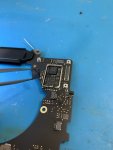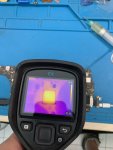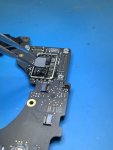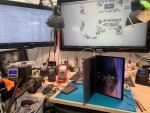george-a
Member
Hi guys,
little water damage at CD3217 closest to the hall sensor on the side where there are 2x CD3217s together.
Cleaned and removed the chip to find out that 3rd ball from the top left (ball 48?) is short to ground (had to remove the other CD3217 to double check although I could also see corresponding the pull-up resistor - no short there).
This signal according to other schematics (820-01700) is TBT_T_CIO_PWR_EN and in 820-01949 is connected using a 10k resistor to 3.3V_LDO. Also in 820-01949 this signal seems to be independent for all CD3217s while in 820-01700 it is shared for each CD3217 pair and doesn't seem to have a pull-up to LDO.
I assume TBT_T_CIO_PWR_EN is the same pad for all CD3217s in all motherboards.
5V/0.275A at USB-C meter.
Any ideas?
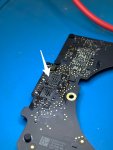
little water damage at CD3217 closest to the hall sensor on the side where there are 2x CD3217s together.
Cleaned and removed the chip to find out that 3rd ball from the top left (ball 48?) is short to ground (had to remove the other CD3217 to double check although I could also see corresponding the pull-up resistor - no short there).
This signal according to other schematics (820-01700) is TBT_T_CIO_PWR_EN and in 820-01949 is connected using a 10k resistor to 3.3V_LDO. Also in 820-01949 this signal seems to be independent for all CD3217s while in 820-01700 it is shared for each CD3217 pair and doesn't seem to have a pull-up to LDO.
I assume TBT_T_CIO_PWR_EN is the same pad for all CD3217s in all motherboards.
5V/0.275A at USB-C meter.
Any ideas?



